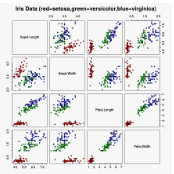There are various cluster validity measures used for evaluating clustering results. One of the main objective of using these measures is to seek the optimal unknown number of clusters. Some measures work well for clusters with different densities, sizes and shapes. Yet, one of the weakness that those validity measures share is that they sometimes provide only one clear optimal number of clusters. That number is actually unknown and there might be more than one potential sub-optimal options that a user may wish to choose based on different applications. We develop two new cluster validity indices based on a correlation between an actual distance between a pair of data points and a centroid distance of clusters that the two points locate in. Our proposed indices constantly yield several peaks at different numbers of clusters which overcome the weakness previously stated. Furthermore, the introduced correlation can also be used for evaluating the quality of a selected clustering result. Several experiments in different scenarios including the well-known iris data set and a real-world marketing application have been conducted in order to compare the proposed validity indices with several well-known ones.
翻译:使用这些措施的主要目的之一是寻找最佳的未知组群数量。有些措施对密度、大小和形状不同的组群效果良好。然而,这些有效性措施共享的一个弱点是,它们有时只提供一个明确的最佳组群数量。这个数字实际上并不为人所知,用户可能希望根据不同的应用选择一个以上的潜在次最佳选项。我们根据一对数据点与两点所在的组群的偏差之间的实际距离的相关性,制定了两个新的组群有效性指标。我们提议的指数经常在不同组群数量上产生若干峰值,以克服先前所述的弱点。此外,引入的关联性还可用于评估选定的组群结果的质量。在不同的假设中进行了一些实验,包括众所周知的iris数据集和真实世界的营销应用,以便将拟议的有效性指数与几个众所周知的指标进行比较。



